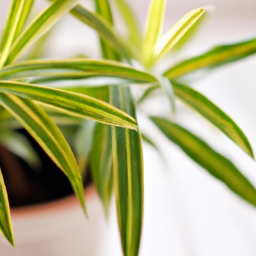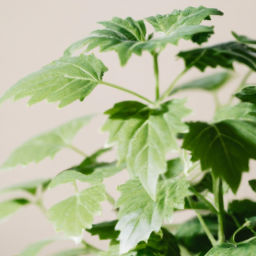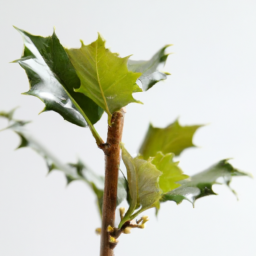
Are you looking for the best plant to grow in your garden or home? Choosing the right plant can make all the difference in creating a beautiful and thriving space. Whether you’re a seasoned gardener or just starting out, finding the perfect plant for your environment and skill level is essential. In this blog post, we’ll explore some of the top contenders for the title of “Best plant to grow” and provide tips on how to care for them to ensure they flourish in your space. So, let’s dig in and discover the perfect plant for you!
The Benefits of Growing Succulents as the Best Plant Choice
Low Maintenance
Succulents are known for their low maintenance requirements, making them an excellent choice for beginners or busy individuals. These plants have adapted to survive in arid environments by storing water in their leaves, stems, or roots. This means they require minimal watering compared to other types of plants. In fact, overwatering is one of the most common mistakes people make when caring for succulents. To ensure the health of your succulents, it’s essential to let the soil dry out completely between waterings. Additionally, succulents thrive in bright, indirect sunlight, making them ideal for indoor spaces with plenty of natural light.
Another benefit of growing succulents is their ability to thrive in a variety of environments. Whether you live in a dry desert climate or a humid coastal region, there is a succulent species that will flourish in your area. Some succulents are even cold-hardy and can withstand frost and snow, making them suitable for outdoor gardens in colder climates. With their adaptability and resilience, succulents are a versatile plant choice for gardeners of all experience levels.
In addition to their low maintenance requirements, succulents are also known for their long lifespan. With proper care, succulents can live for many years, making them a sustainable and cost-effective plant choice. Some succulents, such as the jade plant or aloe vera, can even be passed down from generation to generation, becoming cherished family heirlooms. By choosing succulents as your go-to plant, you can enjoy their beauty and benefits for years to come.
Aesthetically Pleasing
One of the main reasons why succulents have become increasingly popular in recent years is their unique and eye-catching appearance. With their diverse shapes, sizes, and colors, succulents can add a touch of beauty and personality to any space. Whether you prefer the classic rosette shape of an echeveria or the trailing vines of a string of pearls, there is a succulent variety to suit your taste and style.
Succulents are also versatile when it comes to decorating your home or garden. They can be planted in individual pots or grouped together in a succulent arrangement to create a stunning centerpiece. Succulents can also be incorporated into terrariums, wreaths, or living walls for a creative and modern touch. With their ability to thrive in small spaces and unique growing conditions, succulents offer endless possibilities for creative expression and design.
In addition to their aesthetic appeal, succulents have been scientifically proven to have mood-boosting and stress-relieving properties. Studies have shown that being around plants, such as succulents, can improve mental health, reduce anxiety, and increase feelings of happiness and well-being. By surrounding yourself with succulents, you can create a calming and rejuvenating environment that promotes relaxation and positivity.
Air-Purifying Qualities
Another benefit of growing succulents is their air-purifying qualities. Like other houseplants, succulents can help remove toxins and pollutants from the air, improving indoor air quality and creating a healthier living environment. Succulents absorb carbon dioxide during the day and release oxygen at night, making them an excellent choice for bedrooms or other spaces where air circulation may be limited.
In addition to producing oxygen, succulents also emit moisture through a process called transpiration, which can increase humidity levels in indoor spaces. This can be especially beneficial during the dry winter months or in arid climates where humidity levels are low. By incorporating succulents into your home or office, you can create a more comfortable and breathable atmosphere that promotes overall well-being.
Overall, succulents are an excellent choice for anyone looking to add a touch of beauty, tranquility, and health to their living space. With their low maintenance requirements, aesthetic appeal, and air-purifying qualities, succulents offer a wide range of benefits that make them the best plant choice for both experienced and novice gardeners alike. So why wait? Start growing succulents today and experience the joys of caring for these unique and rewarding plants.

The Best Plant to Grow Indoors
Factors to Consider When Choosing the Best Plant to Grow Indoors
When it comes to choosing the best plant to grow indoors, there are several factors that you should consider to ensure the success of your indoor garden. From lighting requirements to space constraints, each factor plays a crucial role in determining which plant is best suited for your indoor environment.
Lighting Requirements
One of the most important factors to consider when choosing the best plant to grow indoors is the lighting requirements of the plant. Different plants have different light needs, with some requiring full sun and others thriving in low light conditions. Before selecting a plant for your indoor garden, make sure to assess the amount of natural light that your space receives and choose a plant that can thrive in those conditions.
For plants that require more light, you may need to supplement with artificial grow lights to ensure that they receive the necessary amount of light to grow and thrive. On the other hand, if your space has limited natural light, opt for plants that can thrive in low light conditions such as pothos, snake plants, or peace lilies.
It’s also important to consider the direction of your windows and the intensity of the sunlight that enters your space throughout the day. South-facing windows tend to receive the most light, while north-facing windows may provide limited light. By understanding the lighting conditions in your space, you can choose a plant that will thrive in your indoor environment.
Space Constraints
Another factor to consider when choosing the best plant to grow indoors is the amount of space available in your indoor garden. Some plants, such as fiddle leaf figs or monstera plants, can grow quite large and may require ample space to spread out and grow to their full potential. If you have limited space, consider opting for smaller plants such as succulents, air plants, or herbs that can thrive in smaller containers.
When selecting plants for your indoor garden, also consider the height and spread of the plant at maturity to ensure that it will fit comfortably in your space. If you have high ceilings, you may opt for taller plants that can add vertical interest to your indoor garden. On the other hand, if you have limited floor space, consider hanging plants or wall-mounted planters to maximize your growing area.
Additionally, consider the growth habits of the plant and whether it requires additional support such as trellises or stakes to grow upright. By selecting plants that are well-suited to your space constraints, you can create a thriving indoor garden that complements your home decor.
Watering and Maintenance
When choosing the best plant to grow indoors, it’s important to consider the watering and maintenance requirements of the plant. Some plants, such as succulents and cacti, require infrequent watering and can thrive in drier conditions. On the other hand, tropical plants may require more frequent watering and higher humidity levels to thrive indoors.
Before selecting a plant for your indoor garden, make sure to research the specific watering and maintenance needs of the plant to ensure that you can provide the necessary care for its growth and development. Consider factors such as soil moisture levels, humidity requirements, and fertilization needs to create an optimal growing environment for your plant.
It’s also important to consider the ease of maintenance of the plant and whether you have the time and resources to care for it properly. Some plants may require regular pruning, repotting, or pest control measures to keep them healthy and thriving. By selecting plants that align with your maintenance capabilities, you can create a sustainable indoor garden that brings joy and beauty to your home.

Top 5 Low-Maintenance Plants That Are Ideal for Beginners to Grow
Introduction
Are you new to gardening and looking for plants that are easy to care for? Look no further! In this guide, we will explore the top 5 low-maintenance plants that are perfect for beginners to grow. These plants require minimal attention and are perfect for those with busy schedules or little experience in gardening. Let’s dive in and discover the best plants to add to your indoor or outdoor garden.
Snake Plant
The Snake Plant, also known as Mother-in-Law’s Tongue, is a popular choice for beginners due to its hardy nature and ability to thrive in low light conditions. This plant is perfect for those who often forget to water their plants, as it can go for weeks without needing to be watered. The Snake Plant is also known for its air-purifying properties, making it a great addition to any indoor space. To care for your Snake Plant, simply place it in indirect sunlight and water sparingly, allowing the soil to dry out between waterings.
Another benefit of the Snake Plant is its ability to adapt to various environments, making it a versatile choice for both indoor and outdoor gardens. Whether you have a sunny balcony or a shady corner in your home, the Snake Plant will thrive with minimal care. With its striking vertical leaves and low maintenance requirements, the Snake Plant is a must-have for any beginner gardener.
In addition to its easy care requirements, the Snake Plant is also known for its resilience to pests and diseases, making it an ideal choice for those looking for a hassle-free plant. With its sleek, modern appearance and air-purifying qualities, the Snake Plant is a top pick for beginners looking to add a touch of greenery to their space.
Succulents
Succulents are another low-maintenance plant that is perfect for beginners to grow. These drought-tolerant plants come in a wide variety of shapes, sizes, and colors, making them a fun and versatile option for any garden. Succulents require minimal watering and can thrive in a variety of conditions, making them an ideal choice for those who are new to gardening.
To care for your succulents, simply place them in a sunny spot and water sparingly, allowing the soil to dry out completely between waterings. Succulents are known for their ability to store water in their leaves, making them highly resilient to drought and neglect. With their unique shapes and textures, succulents are a great way to add visual interest to your garden without the need for constant maintenance.
One of the best things about succulents is their ability to propagate easily, making them a great plant for beginners to experiment with. Simply remove a leaf from your succulent, allow it to dry out, and then plant it in soil to watch it grow into a new plant. With their low maintenance requirements and endless possibilities for propagation, succulents are a top choice for beginners looking to grow their green thumb.
Pothos
Pothos, also known as Devil’s Ivy, is a popular low-maintenance plant that is perfect for beginners to grow. This trailing vine plant is highly adaptable and can thrive in a variety of conditions, making it a great choice for those who are new to gardening. Pothos is known for its heart-shaped leaves and trailing growth habit, making it a beautiful and versatile addition to any indoor space.
To care for your Pothos plant, simply place it in indirect sunlight and water when the top inch of soil feels dry to the touch. Pothos plants are highly resilient and can tolerate a range of light conditions, making them perfect for those with limited natural light in their homes. With their fast growth rate and ability to thrive in low light, Pothos plants are a great way to add greenery to any room with minimal effort.
One of the best things about Pothos plants is their air-purifying qualities, making them a great choice for those looking to improve indoor air quality. Pothos plants are known for their ability to remove toxins from the air, making them a valuable addition to any home or office space. With their low maintenance requirements and air-purifying benefits, Pothos plants are a top pick for beginners looking to enhance their indoor environment.
In conclusion, the top 5 low-maintenance plants that are ideal for beginners to grow include the Snake Plant, Succulents, and Pothos. These plants require minimal care and are perfect for those with busy schedules or little experience in gardening. Whether you are looking to add greenery to your indoor space or create a low-maintenance garden outdoors, these plants are sure to thrive with minimal attention. So go ahead and start your gardening journey with these easy-to-grow plants!
Let’s recap
Are you looking to start a home garden but not sure which plants to grow? Look no further than the versatile and easy-to-care-for succulent! Succulents are the perfect plant for beginners and experienced gardeners alike. They come in a variety of shapes, sizes, and colors, making them a fun and unique addition to any indoor or outdoor space. Plus, succulents require minimal watering and can thrive in a wide range of environments, making them a low-maintenance option for those with busy schedules.
Not only are succulents aesthetically pleasing, but they also offer a number of health benefits. Studies have shown that having plants in your home can improve air quality, reduce stress, and boost mood and productivity. With their ability to purify the air and add a touch of greenery to any space, succulents are a great choice for anyone looking to bring a little bit of nature indoors. So whether you’re a seasoned gardener or just starting out, consider adding a few succulents to your plant collection for a beautiful and beneficial addition to your home.
Here are this week’s Top Questions and Answers
Q1: What is the best plant to grow for beginners?
A1: For beginners, we recommend starting with easy-to-grow plants like succulents, herbs, or spider plants. These plants require minimal maintenance and are perfect for those new to gardening.
Q2: What is the best plant to grow indoors?
A2: If you’re looking to grow plants indoors, consider options like pothos, snake plants, or peace lilies. These plants thrive in indoor environments with limited sunlight and are low-maintenance.
Q3: What is the best plant to grow for a small space?
A3: For small spaces, consider growing plants like dwarf varieties of fruit trees, cherry tomatoes, or compact herbs like basil or mint. These plants can thrive in limited space and are perfect for balconies or small gardens.
Q4: What is the best plant to grow for fresh produce?
A4: If you’re looking to grow fresh produce, consider planting vegetables like tomatoes, peppers, or lettuce. These plants are easy to grow and can provide you with a bountiful harvest of fresh, homegrown produce.
Q5: What is the best plant to grow for improving air quality?
A5: To improve air quality in your home, consider growing plants like peace lilies, spider plants, or aloe vera. These plants are known for their air-purifying properties and can help remove toxins from the air.
Dr. Olivia Green is a botanist with over two decades of experience in indoor plant cultivation. She holds a Ph.D. in Plant Biology and has dedicated her career to researching plant behavior in controlled environments. Dr. Green is passionate about helping plant enthusiasts master the art of indoor gardening through her extensive knowledge and practical insights.


